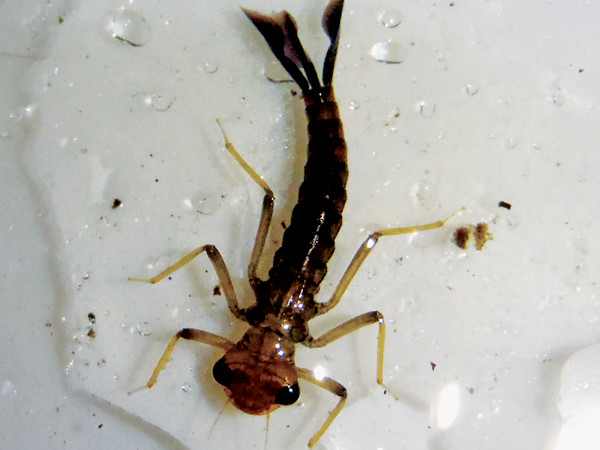
by Jay R. Thompson Tuesday, May 28, 2013

Removal of predators, such as this bromeliad-inhabiting damselfly larvae (_Mecistogaster modesta_), raises carbon dioxide concentrations in the bromeliad's natural water pool. Edd Hammill
Habitat loss, overfishing and invasive species can damage ecosystems, but the loss of predators in particular may have worse consequences than previously thought. In a new study, scientists show that the absence of freshwater predators sharply influences an ecosystem’s carbon dioxide emissions.
“Freshwater plays a very important part in global carbon cycles, but until recently, it was kind of ignored in global carbon models,” says Trisha Atwood, an ecology doctoral student at the University of British Columbia who led the new study. Atwood explains the effect of predators: Start with a three-tier food chain of plants, insects and rainbow trout. “If we remove the trout, the trout are no longer eating the insects, which means the insects can really eat the plant matter.” Fewer plants leads to less carbon dioxide absorption, she says. To test this hypothesis, Atwood and a team of researchers created three controlled ecosystems, each with a three-tier food chain.
In 10 experimental freshwater ponds — each about the size of a bathtub — researchers introduced micro-algae and zooplankton. To half of the ponds they added five plankton-eating fish and let nature take its course for 530 days in the open air of Vancouver, B.C. They also used six controlled streams, connected to natural streams in Maple Ridge, B.C., to which the researchers added dead leaves as food for the detritus-feeding organisms flowing through. In half of the streams they maintained a population of local predatory stonefly larvae for the 70-day experiment. The third ecosystem was studied in the Área de Conservacion Guanacaste, in Costa Rica, where researchers added detritus and detritus-feeding larvae to 20 teacup-sized water pools holding bromeliad plants. They added one predatory damselfly larvae each to 10 of the plants, and then covered all 20 pools with a fine-mesh screen to contain the systems for 40 days.
The researchers monitored carbon dioxide concentrations by sampling the water with leak-proof syringes, injecting samples into vacutainers, and then analyzing carbon dioxide concentrations with a gas chromatograph. In all three experiments, they found a stark difference between systems with predators and those without. Regardless of the type of predator, prey, plant or climatic region, the absence of predators led to increased carbon dioxide emissions, the researchers reported in Nature Geoscience. “For some of our experimental ecosystems, the absence of predators actually caused an increase of up to 93 percent,” Atwood says. “We didn’t really think it would be that big of a difference — it was a bit shocking,” she says.
The implication is that overfishing, extinctions and species invasions not only reduce biodiversity, but may weaken the biosphere’s ability to moderate its carbon flux. However, it’s not likely that climate researchers are going to alter their computer models’ global carbon budget based on the new study, says Daniel Schindler, an ecosystem ecologist at the University of Washington who was not involved in the study. “I think it’s a good study,” Schindler says. “The main reservation I have is about how the types of ecological processes we see in this controlled experiment translate into the real world,” he says.
Furthermore, he adds, not every food chain has three tiers, and carbon emissions from some four-tier systems can be reduced if the top predator is removed, Schindler says. In fact, Atwood and colleagues noted in their study that odd-numbered food chains are generally thought to be carbon sinks while even-numbered food chains emit carbon dioxide. So, as Schindler says, a four-tier food chain is naturally a carbon dioxide emitter, and eliminating or reducing the top predator can make it into a carbon sink like a three-tier or five-tier food chain.
“Fishermen are pretty good at removing those top predators, so the irony is we’ve probably made some ecosystems more productive [as carbon sinks],” Schindler says. Also, fertilizer runoff encourages the growth of algae, which absorb carbon, he says. Because so much of the new study was highly controlled, Schindler says he thinks the next step would be to perform similar research in natural ecosystems.
© 2008-2021. All rights reserved. Any copying, redistribution or retransmission of any of the contents of this service without the expressed written permission of the American Geosciences Institute is expressly prohibited. Click here for all copyright requests.